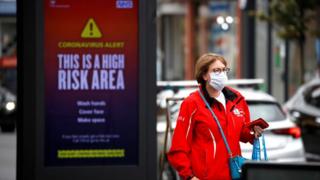 Image copyright
Reuters
Image copyright
Reuters
After a summer of gradual relaxation, the UK faces the prospect of further nationwide restrictions. But about a fifth of the population already know what it's like to go back into lockdown.
So what can we learn from those areas about the effect of a new lockdown on cases, hospitalisations and deaths?
Not all lockdowns are created equal
Since July, more than 10 million people have come under some form of new curbs to their freedom, from pub closures to a complete ban on mixing with other households.
Restrictions were brought in at different points in local outbreaks.
Given that many local restrictions have been implemented so recently, it is difficult to assess how effective they've been. However, data from Leicester, Leicestershire and Greater Manchester, which have been subject to restrictions for longer periods, provide some insight.
In Leicester, action was taken fairly late, once cases had surpassed 140 per 100,000 people.
But once brought in, the measures were stringent, preventing shops and pubs from opening, and households from gathering indoors.
Lockdown has had a visible impact on cases.
Allowing for the fact that some people might change their behaviour a little before or after a formal lockdown is announced, the rise and fall in case numbers tracks very closely with measures being implemented, and then eased again.
Pubs, restaurants, gyms and beauty salons were gradually allowed to reopen from the beginning of August to the start of September. However, there are still limits on gatherings across the city.
In Greater Manchester, a slightly different approach was taken. Measures were brought in sooner than in Leicester - when cases hit about 80 per 100,000 people - but they were softer initially.
Gatherings with other households were banned, but shops, pubs and restaurants remained open. Where restrictions were softer, the pattern was far less clear than in Leicester.
The rate dipped in the period limits were introduced, particularly in Oldham, but any changes were short-lived and the general trend across Greater Manchester is that cases are rising.
'Confirmed' cases
When we talk about cases, what we're really seeing is how many cases are being confirmed through testing - and this can vary wildly depending on how much testing you do.
Testing has been troubled in recent weeks. But earlier in the summer, huge resources were focused on areas with outbreaks, including testers going door-to-door to swab people, regardless of symptoms.
The government doesn't publish a breakdown of testing by local authority, so it's difficult to see exactly how big an effect this is having.
Public Health England does publish positivity rates - positive tests as a proportion of all tests carried out - by region.
This makes earlier increases in cases look a little less steep than they do from confirmed cases alone. But it shows recent rises in case numbers have been genuine, and not just an artefact of testing.
While case numbers are skewed by how many tests are being done, hospital admissions are a more consistent measure.
Looking at both hospital admissions and deaths in Leicester brings home how much impact its second lockdown had.
A rise in hospital admissions was stopped in its tracks and reduced - only to come back up again in recent weeks, as restrictions have eased and testing has been inaccessible to many.
Coronavirus deaths in the city also saw a sustained decrease, with Leicester recording fewer than five deaths a week in the month to 7 September.
In Greater Manchester, again the picture is less dramatic. But hospital admissions do appear to have been kept at a low level following the introduction of restrictions.
It's possible the measures still did something to protect the most vulnerable, even if they didn't have as noticeable an impact on overall cases.
And, perhaps because some restrictions were brought in at an earlier stage, the rise in cases doesn't appear to have led to higher mortality from coronavirus.
But local hospitalisation data has only been published up to 2 September. National data shows hospital admissions for covid have been creeping up since then.
In fact, since 2 September the number of people in hospital with coronavirus in the north-west has tripled to 393 - the highest since 6 July.
That hasn't yet translated to an increase in the number of people dying, but that will be the fear.
The data confirms that curbs in local areas can have a considerable impact, and the tighter they are, the bigger the impact on cases.
Fundamentally, the virus needs people to be in close contact and mixing between circles to spread through the population.
But it also indicates that the impact is far from permanent - relax the restrictions and allow more contact, and the virus will quickly start to spread again.
Unless and until a viable vaccine becomes available, government will be faced with the same choice: shut down large chunks of society or allow the virus to tear through communities, with little idea of the true toll that either will exact.

 5 years ago
813
5 years ago
813 

